Author: Zuo Ye
The network effect extends beyond the internet.
Water and electricity grids possess strong exclusivity, making them suitable for "monopolistic" collective management, which can either benefit or harm society as a whole. However, the network of relationships among people is inherently distributed and decentralized; even the most socially adept individuals find it challenging to know everyone.
Is crypto fundamentally a network of capital, or is it a space for interaction among people?
Satoshi Nakamoto clearly believed it was the latter. The peer-to-peer trading model marks the beginning of the cryptocurrency space's history, which has evolved alongside the appreciation and expansion of capital, fully embracing the connections of capital while diminishing direct interactions among people.
The only reasonable question is: how long can the density of this capital network sustain itself before it collapses?
Why the Market is Recovering
Many are still trapped in the aftermath of the crashes on October 11 and November 3, pondering how long it will take for synthetic stablecoins, vaults, and yield products to recover. However, the growth models of Hyperliquid's BLP and HIP-3 are emerging, and the stablecoin YC prepared by Framework is now live on Sky.
Additionally, Aave's sudden arrival of V4 and mobile financial product apps.
From an absolute data perspective, it is indeed a market recovery period, but from a sensory perspective, project teams seem to be tightly grasping historical trends to innovate.
In other words, the market cycle has decoupled from retail investor activity, which is not uncommon. The fundamentals of the U.S. economy have little to do with the real industry; what matters most to Trump is interest rate cuts and stock prices. Americans and the real industry are merely a part of the play.
In this cycle, if one still believes in the four-year cycle of Bitcoin, they are merely stuck in a time machine from 2017. Just like the flash crash of CloudFlare, the infrastructure of crypto is constantly changing.
Hyperliquid's DEX is indeed capturing the CEX market, especially in conjunction with memes, altering token valuation, pricing, and distribution systems. The era of CEX is visibly declining, with Kraken valued at only $20 billion, while many CEXs are pivoting to support their own DEXs.
As the high FDV of 2024 impacts Binance's pricing system, VCs are already out of the picture, leading to a market dominated by market makers: Hyperliquid and other Perp DEXs are backed by market makers, and many YBS projects are also supported by market makers.
SBF came from Jane Street, Jeff from Hudson River Trading, and the founder of Variational from the market-making department of DCG.
Even the market makers faced the brunt of the ADL liquidation on October 11, where fortune and misfortune are intertwined. The market structure dominated by market makers is more rigid and rapid than that dominated by CEX.
Web3Port is aggressively selling operational tokens, and DWF is repeatedly manipulating token prices. Even Hyperliquid's HLP faces such accusations. Whether centralized market makers or decentralized treasuries, as long as they participate in the market-making system, they cannot escape the suspicion of market manipulation.
If we call the current market structure a "recovery," then the market makers have been severely impacted, rendering them unable to continue manipulating the market, which instead leads to market stabilization.
This is not uncommon; before the collapse of FTX in 2022, rumors circulated that Alameda once held a 20% market-making share in BTC. In SBF & FTX's biography "Going Infinite," SBF admitted they were one of the earliest professional companies to engage in large-scale market making.

Image Caption: BTC liquidity plummets
Image Source: @KaikoData
Returning to the flash crash of October 11, from the perspective of market makers, it was purely a technical crisis, or rather, the trading liquidity before that was a technical boom: there were no retail investors trading; it was market makers buying and selling.

Image Caption: Liquidity plummets on October 11
Image Source: @coinwatchdotco
The existence of market makers is not the problem, but for altcoins or newly launched TGE coins, it signifies massive sell-offs. Airdrop hunters and yield farmers, even VCs and project teams themselves, will resolutely sell to market makers to lock in profits.
Market makers find themselves in a dilemma: if they do not manipulate the market, they will inevitably absorb all the junk coins, or they become the Lich King, trying to increase market volatility as much as possible, earning a little for themselves while occasionally allowing market participants to earn a bit too.

Image Caption: Mainstream market maker holdings
Image Source: @arkham
The reasoning here has a significant flaw; it can only observe the composition and changes of market makers' holdings, making it difficult to analyze how they manipulate token prices within CEX. The data from DEXs like Hyperliquid is relatively transparent, leaving room for future analysis.
In summary, the market is not rebounding; rather, market makers have suffered severe blows, coupled with the successive explosions of YBS projects, leading to their inability to manipulate the market. What we see now is the real price mechanism at work.
There is no recovery, only honesty.
The 70% Law of Natural Monopoly
The various segments of crypto are beginning to show products with "natural monopoly" characteristics, such as EVM, which is relatively a failure compared to the Bitcoin network as infrastructure. Everyone desires BTC but does not want to engage in P2P transactions.
Aside from proponents like Jack Dorsey insisting on using the Bitcoin network as a stablecoin chain, the dream of BTCFi has already proven to be both real and tragic. Stopping the imagination surrounding it would benefit the entire industry.
Outside of EVM, only Binance and USDT as super products come close to the concept of "monopoly." Note that this does not conflict with CEX facing the impact of DEX or the innovations of USDC/USDe/YBS/Curator.
Super Products ≠ Segments
In other words, Binance and USDT are working hard to resist entropy, while Ethereum has gone through a series of self-destructive events (infinite gardens, L2 scaling -> L1 scaling), and even now pivoting towards privacy and AI, EVM remains the mainstream choice despite the whims.
However, the market share of Binance and USDT, as well as Hyperliquid's share in Perp DEX, is roughly capped at around 70%, after which more market actions are needed to solidify their current positions.

Image Caption: Market share under a solid market structure
Image Source: @GLC_Research @defillama @SPGlobal
Empirical observations suggest that under a solid market structure, the top projects can occupy 70% of the market share in that segment. However, the market environment changes over time, and currently, the shares of Hyperliquid, USDT, and Binance have all dropped below 50%.
Of course, EVM remains absolutely stable in the overall VM segment, with only a few competitors like SVM or Move VM that can be considered as entering a super-stable structure.

Image Caption: Mainstream market makers
Image Source: @coinwatchdotco
Revisiting market makers from this perspective, we know that there are at most 20 mainstream market makers, and it is speculated that they held a dominant market position before October 11. However, they have not achieved a natural monopoly status, and even if they forcibly maintain it, they are now at the end of their rope.
So how will the market structure change in the next phase?
New and Old Alternating
- Following the path of traditional finance will limit valuation by traditional financial valuation models.
- Following the path of internet financial technology companies will limit valuation by internet scale.
- Finding a valuation model suitable for the crypto space, not defined by any existing industry, is the only way to roll out a $5 trillion top player like AI.
Recently, the market has indeed been strange. Solana, as a pioneer in RWA and institutional adoption, saw its foundation chair Lily Liu suddenly express a desire to revive the crypto punk dream, combining with Ethereum to return to the L1 Scaling route, along with the previously mentioned privacy concept, which has become immensely popular since Zcash.
Crypto seems to be rediscovering the technical logic and valuation system of the crypto space, and these are increasingly less related to market makers. Even with institutional adoption, it is more about "crypto projects using institutional funds for DeFi" rather than "selling crypto DeFi to institutions."
In summary, internally removing market makers and externally shedding institutions.
Even OGs must keep up with the new era; the DAT co-founded by Li Lin and Xiao Feng has also been stillborn. After piercing through Chinese VCs, the Big Name effect of OGs is also heading into history.
Crypto is reclaiming its dreams, at the cost of shedding its parasitic system.
Referring to the most mature U.S. capital market, A16Z is a part of it, but Chinese VCs are not. Government, state-owned enterprises (state capital groups), and internet companies (previously) are the ones with money.
Mapping this to the situation of Chinese VCs in Web3, they lack the ability to participate in the market's pricing and distribution systems. Market makers and CEXs once did, but after October 11, the trend towards on-chain has become increasingly clear.
On-chain ≠ Decentralization.
A typical example is Hyperliquid, which is transparent on-chain but not decentralized in terms of physical nodes and token economics.
Even the capitalization reform of state-owned enterprises in reality is not merely about selling old for new; it is about investing in new industries to exchange for a ticket to a new world.
From this perspective, the biggest problem with market makers is similar to that of memes: liquidity lacks a value system. In the extreme void of PVP, they may earn a lot, but market makers cannot serve as a dominant force in the industry.
Dreams and technological long-termism: Vitalik has done too much, while market makers have done too little; moderation is still necessary.
Conclusion
Essentially, this article is written for myself. Theoretically, the market should have stagnated after October 11 and November 3, but the decline in TVL has not hindered DeFi's innovation and self-repair, which leaves me perplexed.
Vaults, YBS (yield-bearing stablecoins), and Curators are still evolving. The market is more resilient than we imagine. If one still holds onto the views from a month ago or even a week ago to assess the market, they will fail to understand it.
In the post-market maker dominated era, the balance of values and product profitability in the crypto space will redefine valuation logic.
免责声明:本文章仅代表作者个人观点,不代表本平台的立场和观点。本文章仅供信息分享,不构成对任何人的任何投资建议。用户与作者之间的任何争议,与本平台无关。如网页中刊载的文章或图片涉及侵权,请提供相关的权利证明和身份证明发送邮件到support@aicoin.com,本平台相关工作人员将会进行核查。


